Ragenar (Latin Ragenarius, French Ragenaire or Réginaire) was the bishop of Amiens from 830 to 833 and again from 834 until his death in 849. His predecessor, Jesse, was initially deposed by the Emperor Louis the Pious in 830 for conspiring with his rebellious son Lothair. In 833 he was restored when Lothair forced his father to make public obeisance at an assembly in Soissons. When Louis regained his position in 834, Jesse was again deposed and this time exiled to Italy, where he died in 836.

Louis the Pious, also called the Fair, and the Debonaire, was the King of the Franks and co-emperor with his father, Charlemagne, from 813. He was also King of Aquitaine from 781.

Lothair I or Lothar I was the Holy Roman Emperor, and the governor of Bavaria (815–817), King of Italy (818–855) and Middle Francia (840–855).
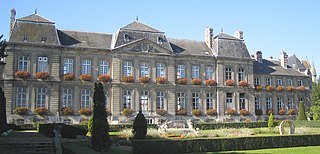
Soissons is a commune in the northern French department of Aisne, in the region of Hauts-de-France. Located on the Aisne River, about 100 kilometres (62 mi) northeast of Paris, it is one of the most ancient towns of France, and is probably the ancient capital of the Suessiones. Soissons is also the see of an ancient Roman Catholic diocese, whose establishment dates from about 300, and it was the location of a number of church synods called "Council of Soissons".
Ragenar signed a charter of Archbishop Aldric of Sens giving a privilege to the abbey of Saint-Remy in the diocese of Sens. He was present at the Synod of Thionville in 835, where Archbishop Ebbo of Reims, who with Lothair had restored Jesse to Amiens in 833, was deposed. In 840, after the Emperor Louis's death, he attended the synod at Worms where Ebbo was restored.
The Synod of Thionville was an important synod of ecclesiastic dignitaries of the Carolingian Empire in 835.
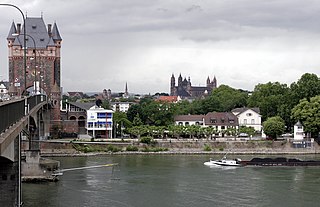
Worms is a city in Rhineland-Palatinate, Germany, situated on the Upper Rhine about 60 kilometres south-southwest of Frankfurt-am-Main. It had approximately 82,000 inhabitants as of 2015.
Ragenar, at the head of a small force raised from the temporalities of his diocese, was part of the army which was on its way south to Toulouse to join King Charles the Bald when it was ambushed by King Pippin II of Aquitaine in the Angoumois on 14 June 844. Ragenar was among the captives while the king's uncle, Hugh, was among the dead. Ragenar remained a prisoner until May 845. That year he managed to attend the synod of Beauvais where Hincmar was chosen to succeed Ebbo.

Toulouse is the capital of the French department of Haute-Garonne and of the region of Occitanie. The city is on the banks of the River Garonne, 150 kilometres from the Mediterranean Sea, 230 km (143 mi) from the Atlantic Ocean and 680 km (420 mi) from Paris. It is the fourth-largest city in France, with 466,297 inhabitants as of January 2014. In France, Toulouse is called the "Pink City".

Charles the Bald was the king of West Francia (843–877), king of Italy (875–877) and emperor of the Carolingian Empire (875–877). After a series of civil wars during the reign of his father, Louis the Pious, Charles succeeded by the Treaty of Verdun (843) in acquiring the western third of the Carolingian Empire. He was a grandson of Charlemagne and the youngest son of Louis the Pious by his second wife, Judith.
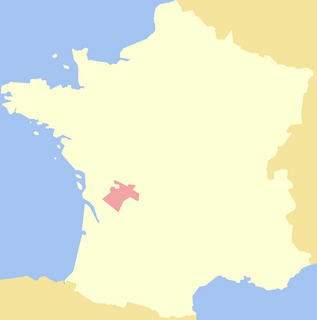
Angoumois or equally historically the comté d'Angoulême was a county and province of France, originally inferior to the parent duchy of Aquitaine, similar to the Périgord to its east but lower and generally less forested, equally with occasional vineyards throughout. Its capital was Angoulême with its citadel and castle above the River Charente.
Ragenar attended the regional synod in Quierzy-sur-Oise, held before Easter (14 April) 849, where the doctrine of Gottschalk of Orbais was condemned. He died later that year, possibly in June. No acts of Ragenar's have been preserved in the meagre first millennium archives of Amiens. He was succeeded by Hilmerad. Some 19th-century scholars placed a second Ragenar after Hilmerad, but this was based on confusion.
Gottschalkof Orbais was a Saxon theologian, monk and poet who is best known for being an early advocate of the doctrine of two-fold predestination. From his friend Walahfrid Strabo, Gottschalk also received the nickname Fulgentius, after Fulgentius the Mythographer, whom he may have studied intensively.
This page is based on this
Wikipedia article Text is available under the
CC BY-SA 4.0 license; additional terms may apply.
Images, videos and audio are available under their respective licenses.

Pope Nicholas I, also called Saint Nicholas the Great, was Pope from 24 April 858 to his death in 867. He is remembered as a consolidator of papal authority and power, exerting decisive influence upon the historical development of the papacy and its position among the Christian nations of Western Europe. Nicholas I asserted that the pope should have suzerain authority over all Christians, even royalty, in matters of faith and morals.

Nominoe or Nomenoe was the first Duke of Brittany from 846 to his death. He is the Breton pater patriae and to Breton nationalists he is known as Tad ar Vro.
Hincmar, archbishop of Reims, was the friend, advisor and propagandist of Charles the Bald. He belonged to a noble family of northern Francia.
Gaucelm was a Frankish count and leading magnate in Gothia during the reign of Louis the Pious. He was initially the Count of Roussillon from about 800, but he received Empúries in 817 and was thenceforward the chief representative of imperial authority in that region.

Pepin I or Pepin I of Aquitaine was King of Aquitaine and Duke of Maine.

Ebbo or Ebo was archbishop of Rheims from 816 until 835 and again from 840 to 841. He was born a German serf on the royal demesne of Charlemagne. He was educated at his court and became the librarian and councillor of Louis the Pious, king of Aquitaine, son of Charlemagne. When Louis became emperor, he appointed Ebbo to the see of Rheims, then vacant after the death of Wulfaire.
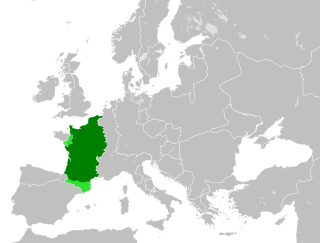
In medieval historiography, West Francia or the Kingdom of the West Franks was the western part of Charlemagne's Empire, ruled by the Germanic Franks that forms the earliest stage of the Kingdom of France, lasting from about 840 until 987. West Francia was formed out of the division of the Carolingian Empire in 843 under the Treaty of Verdun after the death of Emperor Louis the Pious and the east–west division which "gradually hardened into the establishment of separate kingdoms (...) of what we can begin to call Germany and France."

The Roman Catholic Diocese of Amiens is a diocese of the Latin Rite of the Roman Catholic Church in France. The diocese comprises the department of Somme, of which the city of Amiens is the capital.
Hincmar, called the Younger, was the Bishop of Laon in the West Frankish Kingdom of Charles the Bald from 858 to 871. His career is remembered by a succession of quarrels with his monarch and his uncle, archbishop Hincmar of Rheims. After initial loyalty to Charles trouble occurred from 868 due to the allocation of benefices on the see's estates. The conflict grew dangerous as it became embroiled in the larger dispute of Lotharingian succession following Lothair II’s attempted divorce from his wife. Hincmar’s struggle against his king provides a Carolingian example of early Medieval clerical exemption.
Wulfad was the archbishop of Bourges from 866 until his death. Prior to that, he was the abbot of Montier-en-Der and Soissons. He also served as a tutor to Carloman, a younger son of King Charles the Bald. Carloman succeeded Wulfad as abbot of Soissons in 860.
Wenilo was the archbishop of Rouen from 858. He was an appointee of King Charles the Bald.
Wenilo was the archbishop of Sens from 836 or 837. Prior to becoming bishop, Wenilo was a palatine chaplain. As bishop, he was one of the leading men in Aquitaine and crowned Charles the Bald king in 848, definitively uniting Aquitaine with West Francia. In 858, he supported the East Frankish invasion and was denounced as a traitor by the king. He reconciled the next year, and retained his office until his death. Nevertheless, Wenilo passed into legend as Ganelon, the archvillain of the Matter of France, his name a byword for "traitor".
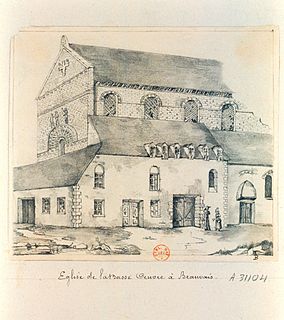
Odo I was a West Frankish prelate who served as abbot of Corbie in the 850s and as bishop of Beauvais from around 860 until his death in 881. He was a courtier and a diplomat, going on missions to East Francia and the Holy See.
Immo was the bishop of Noyon from between 835 and 841 until his death at the hands of a group of Vikings. During the civil war that convulsed the Carolingian Empire following the death of Emperor Louis the Pious in 840, Immo supported the emperor's youngest son, Charles the Bald, from 841.
Guntbold was the archbishop of Rouen from 836 until his death in 849.
There have been several church synods called Councils of Soissons:













